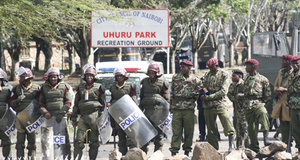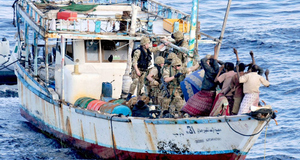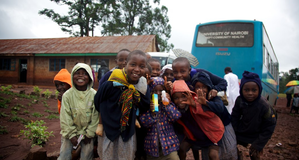Featured Article:Somali Refugees in Kenya: Security Deficiencies and Public Health Concerns as a Result of Ineffective Policy
By
2011, Vol. 3 No. 08 | pg. 1/2 | »
IN THIS ARTICLE
Somalia is home to roughly 9 million people, the overwhelming majority of whom are ethnic Somalis (UN Statistics Division 2010). The country has been plagued with conflict and disorder beginning just years after it attained independence. Following the overthrow of President Siad Barre in 1991 and the chaos that subsequently ensued, Somalis migrated rapidly from inside the boundaries of Somalia and settled in various nearby locations within East Africa. The largest recipient of Somali refugees in Africa is Kenya, with an influx of thousands more every month for roughly the last twenty years. Officially, refugees are confined to designated camps in Kenya; however, it is not uncommon for Somalis to migrate into Nairobi. The Government of Kenya has largely taken a passive approach to refugee assistance and instead, has placed the burden on intergovernmental and nongovernmental organizations. Most significantly, the United Nations High Commissioner for Refugees (UNHCR) has taken the lead to help mitigate the problems posed by refugees within Kenya. [Note: Kenya is home to “a substantial indigenous Somali Kenyan population” (Lindley 2007) living mainly in the North Eastern Province. The history of Somali Kenyans can be traced back to pre-colonialist times; thus, while they differ ethnically from the majority Bantu population in Kenya, the group is, nevertheless, considered Kenyan citizens and not the refugees mentioned in this study]. MethodologyThis study placed foci on the public health and security concerns related to Somali refugees in Kenya, specifically emphasizing the Dadaab refugee camps, the Kakuma camp, and the Eastleigh estate in Nairobi. Methodologically, the study involved a dual approach: First, the author spent three weeks in East Africa conducting ethnographic research. Informal interviews were held with several Kenyans and visual observations were recorded (see appendix 1). While it was not possible to visit any official refugee camps, the Eastleigh estate was viewed as well as a Somali-populated neighborhood in Mombasa. Second, upon returning to the United States, scholarly literature was analyzed to produce a more comprehensive understanding of the history of Somali refugees, the present situation, and hypotheses for the future. A two-pronged approach [primary and secondary sources] to this research topic ensured that the author attained a more comprehensive understanding of the subject. The benefits of ethnography became obvious upon the study’s conclusion. Ethnographic studies frequently focus on everyday contexts and informality. By observing Somali’s in a natural setting, the author was be able to “capture the character of naturally occurring human behavior,” (Genzuk 2003) which thus helped generalize the findings. Utilizing unstructured and informal interviews allowed for flexibility, while maintaining the ethnographic ideology of naturalism. The purpose of these interviews was qualitative and foundational in nature, meaning the results acted as the author’s basic groundwork for understanding Somali refugees. It is important to note that security concerns in many refugee populated areas made the ethnographic portion of the study difficult. Many local Kenyans with whom the author spoke did not wish to talk about Somalis and many visual observations were conducted from a distance. Therefore, the interviews and observations acted as a complement to scholarly journal analysis.BackgroundIn the late 1980s, Kenya became a leading host of refugees from other East African nations. The roughly 12,000 Refugees in Kenya, at that time, enjoyed the legal right to reside anywhere in the country, obtain a work permit and attain an education (Campbell 2006). It was not until the early 1990s when nearly every country surrounding Kenya experienced political crises. Most notably, the severe conflict in Somalia forced a mass influx of refugees into Kenya. By 1992, Kenya held an estimated 400,000 refugees, many of whom were ethnic Somalis. The Government of Kenya [GOK] became overwhelmed with the situation and decided to, in essence, withdraw completely from any refugee humanitarian assistance (Campbell 2006). From the beginning of the conflict in Somalia, thousands of refugees traveled by boat down the coast of Kenya and arrived in Mombasa, where many were forced into official camps. Due to the urban environment in Mombasa, some managed to settle within the city (Verdirame 1999). A number of Somali refugees who lived outside of the camp established small businesses in Mombasa, ranging from electronics stores to black-market activities. Due to a legal policy exempting refugee camps from taxation, many Somalis conducted business within the confines of the official camp, named the Barawan [Hatimy] Refugee Camp, and had great financial success. Of course, this was to the dismay of local business owners, who held significant resentment towards Somali refugees. In 1997, after local businesses put pressure on the GOK to enact policy changes, the camps were officially closed, requiring all refugees to relocate to either Dadaab or Kakuma. The situation was so grim at this point that some refugees opted for repatriation to Somalia (Verdirame 1999). Following this mass repatriation, the number of Somali refugees living in Kenya was nearly halved, although the number of Internally Displaced Persons [IDPs] in Somalia increased drastically. In the words of a Somali refugee interviewed for a research study: “At least in Somalia we can still try to do something with our lives, although it is not easy because of the fighting. But I prefer Somalia to [a refugee camp], where there is nothing one can do. If something goes wrong in Somalia, I will die in my country. If I have to choose my death, I prefer to be shot dead in Somalia than to starve to death in [a camp]” (Verdirame 1999). This makes obvious the philosophical question surrounding refugees in Kenya: What is the purpose of allowing refugees into a country? From a legal perspective, the GOK has been required to accept refugees because it is a “party to the 1951 Refugee Convention” and “ratified the [1969] OAU Convention pertaining to refugees” (Campbell 2006). Although the government has legally abided by the above statutes, it has also created numerous informal and unwritten policies to afford no extra rights or luxuries to refugees. Most notably, Kenyan authorities have continued to allow refugees to enter the country, under the agreement that they “all must reside in designated camps” (Campbell 2006). From an ethical standpoint, conditions in the camps should surely be livable and up to international standards. However, how long should a refugee reside in a camp? Could generous living arrangements increase the likelihood that a refugee will not return home or attempt to build a new life? These are legitimate concerns that are repeatedly considered by the Kenyan Government and UNHCR, both having found no viable middle ground. Urban RefugeesNearly all refugees who do not live within an official camp reside in Eastleigh, “a densely populated low-income area of Nairobi, where the informal economy is flourishing” (Campbell 2006). Historically, the estate [neighborhood] was built by British businessmen in the early 20th century to expand business. Nowadays, Eastleigh is known as Mogadishu Mdogo, a Kiswahili phrase meaning “little Mogadishu.” It remains an area that many non-Somalis avoid due to its “collapsing infrastructure, lawlessness, unplanned growth, and lack of basic services” (Murunga 2005). Simply put, while an official refugee camp may offer slightly better living conditions, Eastleigh provides a “level of invisibility” that a camp lacks (Murunga 2005). Although a substantial amount of legitimate business occurs within Eastleigh, there is still an overwhelming presence of illicit activities, making it possible to purchase anything from a fake passport to a firearm. It is even possible to exchange currency with many Somali refugees, using a “black market” rate that is far superior to the official exchange rate (Personal Interview 2011). Even the legitimate items sold, such as electronics, are brought into the country through the Kenya-Somali border and sold at very low prices compared to other items that are officially imported. The neighborhood is notorious for the above activities, creating a difficult task for the Kenyan Police. Maintaining one of the highest crime rates in Nairobi, Eastleigh frequently experiences unannounced raids by police to check the identification documents of Somalis. The government’s policy makes being found outside of a refugee camp grounds for arrest or detainment” (Nyaoro 2010). There are specific exceptions to this policy, including if a refugee needs to seek health care in Nairobi or has been accepted to an academic institution. Of course, the lack of clear refugee legislation in Kenya makes this a very ambiguous situation, whereby a Somali refugee can be detained for extended periods of time and harassed by the police, only to end up not being officially charged with a crime. The raids conducted by police are frequently in response to anti-Somali sentiment felt by many Kenyans and are indicative of a long and painful relationship between Somalis and Kenyans. For years, Somali refugees have been used as a scapegoat for much of the insecurity and disorder that has plagued Kenya. The fact remains that Somalia, as a country, has been politically unstable for much of its post-colonial existence. Kenyans, therefore, overwhelmingly believe that Somali refugees simply brought problems into Kenya. Any significant event that involves terrorism in Kenya almost certainly brings an increased distrust towards Somalis and a subsequent police raid into Eastleigh. Following the 1998 U.S. Embassy bombings, a police crime crackdown seized over 600 residents of Eastleigh, most of whom were Somali refugees. A similar instance occurred in 2002 when over one thousand illegal immigrants [mainly Somali] were arrested. In 2003, following the American Embassy’s temporary closure in Nairobi, more than one hundred Somalis were detained for questioning (Campbell 2006). It is evident that the Kenyan people and government have a strong sense of fear and distrust towards Somalis, whether based on actual history or fallacy. President Daniel Arap Moi instituted a policy in 2001 that officially closed the Kenya-Somali border. Moi exclaimed that, “although Kenya showed hospitality by accommodating refugees from Somalia, they [refugees] abused their welcome by bringing illegal firearms into the country.” He went on to say that “Somalis were to blame for the current state of insecurity in Kenya” (Murunga 2005). The border closing appears to take place more so in theory than in practice, due to the extensive land border, difficult terrain, and lack of police and immigration officials. Dadaab and KakumaDadaab is a town in the North Eastern Province that houses three refugee camps: Ifo, Hagadera, and Dagahaley. Due to its mere 80 kilometer proximity to Somalia, the overwhelming majority of refugees in the camp are Somali. The compound was originally built in 1991 with the capacity to hold 90,000 refugees. Currently, Dadaab is the largest refugee camp in the world, with recent population estimates showing 350,000 people. The numbers are only expected to grow within the next several years, assuming that the fighting in Somalia does not terminate. The problems in Dadaab are extensive, including extreme overcrowding, high crime rates, lack of resources, and the philosophical issue that, what was once created to temporarily house refugees is now witnessing the births of third-generation Dadaab residents (New York Times 2010). The public health concerns in Dadaab are vast and appalling. Oxfam performed an assessment in 2008 and declared the situation in Dadaab conducive to a public health emergency. According to Human Rights Watch, the “acute malnutrition rate” stands at 13%, affecting mainly women and children. While the World Food Program supplies each refugee with the minimum standards for caloric intake each day, “many refugees are forced to sell food in order to buy essential items” such as firewood (HRW 2009). The water system in Dadaab is inefficient and has not been updated in eighteen years. Due to the lack of water physically available for consumption, each resident is only allowed to obtain 16 liters of water each day – an amount below the recommended minimum standard needed to remain healthy. Furthermore, that does not even account for water needs outside of basic hydration, such as feeding livestock, building construction, and cleaning. In order to meet the minimum international standard for sanitation, over 36,000 latrines would need to be built in Dadaab. The latrine problem is so acute that in 2007, there were two cholera outbreaks. In 2010, the camp experienced nine disease outbreaks, most significantly: cholera, meningitis, H1N1 flu, and pertussis (Global Health Initiative 2010). Such severe overcrowding means that any disease has the potential to become widespread throughout the camp in a very short time span. There are simply not enough healthcare professionals in Dadaab to effectively deal with a disease outbreak or, for that matter, routine care.Continued on Next Page » Suggested Reading from Inquiries Journal
Inquiries Journal provides undergraduate and graduate students around the world a platform for the wide dissemination of academic work over a range of core disciplines. Representing the work of students from hundreds of institutions around the globe, Inquiries Journal's large database of academic articles is completely free. Learn more | Blog | Submit Latest in International Affairs |


















